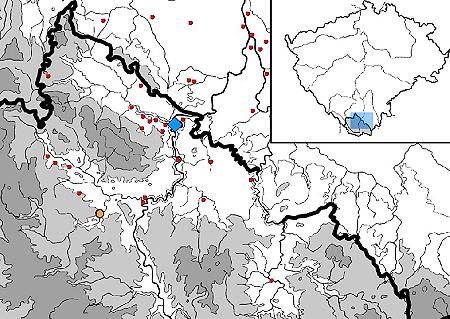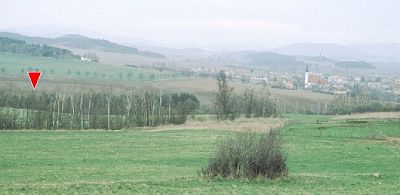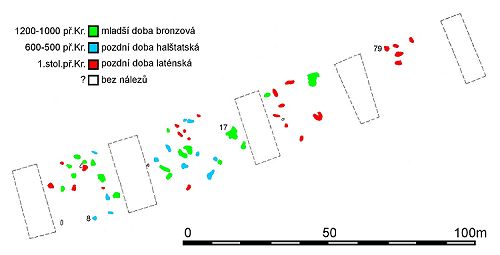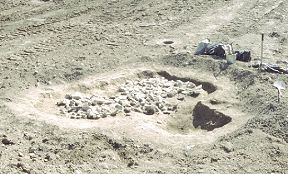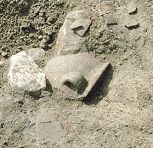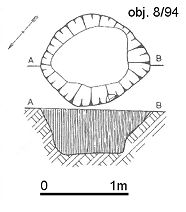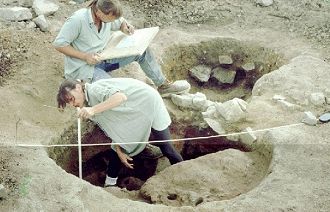The Primeval Settlement of Novosedly near Kájov
In 1994 a new road was being built between the villages of Kladenské Rovné and Kájov, 10 kilometres west of the town of Český Krumlov. During the work of construction some remains of several our ancestors´ places of settlement were discovered by archaeologists, about 400 metres north-east of the village of Novosedly (picture 2). They were able to uncover altogether 86 deepened settlements "buildings" from the Bronze and Iron Age in about 180 metres long and approximately 25 metres wide arable strip (picture 3). In April - June ,1994 archaeologists from the South Bohemia Museum in the town of Český Krumlov, under Dr. Petr Zavřel leadership, searched 57 primeval building relicts and equipment, 29 smaller circular holes - column remains. Originally, they may have supported constructions of local primeval houses.
Discovered localities of Celtic settlement during the 1st century BC are marked in the Český Krumlov region map (according to P. Zavřel) : red-colour points - remains of Celtic settlements and exceptional pottery discoveries; blue-colour rhombus - Celtic settlement of Třísov; orange-colour point - location of the primeval settlement of Novosedly near Kájov. Drawing: Michal Ernée.
The Settlement from the Early Bronze Age (approximately 1200 - 1000 BC, stage HaA) The oldest discovered signs of settlement - deepened buildings of settlement - belonged to "Members of Knovízská Culture" from the early Bronze Age. There were 18 different - shaped and size holes sunk into the groundwork. We have not been able to determine their original function so far. They could have been used, for example, as storage room - storage holes or could have been remains of clay mining. Clay was used in order to be spread all over walls made of interwine wickers or to make pottery. Finally they were also used as waste holes - rubbish and no longer needed things were thrown there. There is a possibility that most of discovered articles, especially pottery vessel fragments, got into their filling. Some parts of large storage vessels with decorated rims (pictures 6, 7 on the left), as well as some bowl and cup fragments. Clay fragments are also worth mentioning.
Besides almost one hundred pottery vessel fragments discovered in deepened object No. 17 (picture 5), a huge stone broken ground was uncovered and proved by documentary evidence. So far its function has not been cleared - it could have been the remains of a building construction or remains of purposufully designed area of stone, originally used in order to produce or process something. One corn grinder made of stone was discovered by archaeologists among broken ground stones.
The Settlement from the Late Halstat Period (approximately 600 - 500 BC, stage HaD). Twelve different-shaped and depth holes have been preserved since the late Iron Age. They were situated in the west part of the searched area. Originally, the place of settlement had continued out of that area. Only pottery vessel fragments were excavated from the searched objects. A large number of pottery fragments with decoration typical for that period was discovered in circle storage(?) hole No. 8 (picture 8). A bowl with intarzie decoration and bent spout (picture 7 on the left) can be taken as an example. Its surface was made of graphite, decorated on the outside and engraved on the inside. It is a pity there are only some fragments of a such beautiful vessel left.
The Settlement from the Late Lathen Period (approximately the first half of the 1st century BC, stage LtD). The period of Celtic rule ending - the period of Celtic settlement existence - is represented most. It relates to the number and quality of searched objects, as well as the number of discoveries. Altogether 23 bigger deepened buildings from the late Lathen Period were spread along the whole searched area almost equally. The Celtic settlement had originally continued out of that searched area in all directions. It must have been several hectares in size.
Besides different-shaped and size holes, some remains of a unique and quite well-preserved kiln - object No. 17 (pictures 9 - 12) were also successfully examined. The kiln is the only object which original function was clearly determined. The kiln uncovered in the settlement of Novosedly near Kájov ranks among two - chamber kilns with the circle grate and two stove pipes. Similar kilns were very common at Bohemia settlements during the Lathen Period. However, there has only been one discovery of that type in South Bohemia so far. Almost 240 pottery fragments (examples in picture 12), which is 10% of all pottery discovered during that archaeological research, were discovered in the kiln destruction. Besides pottery, the Celts were engaged in spinning. Some whorls made of clay prove that.
|
Obr. 4 |
Obr. 5 |
The Celtic settlement of Novosedly near Kájov was probably connected with the Celtic settlement of Tšísov (picture 1). It could also have taken advantage of its location along the thoroughfare leading through the Polečnice River Basin to the south into the Podunají area.
|
Obr. 6 |
Obr. 7 |
The Settlement of Novosedly near Kájov. It has the most southward location from all settlements. It has an elevation of 560 - 570 metres. It was the first modern research of the primeval settlement in the Český Krumlov region done in 1994. Even though the elevation is so high, the settlement is situated in a favourable location on the gentle south - east slope near the Polečnice River. Primeval settlers had been interested in favourable locations as it was proved thanks to a large number of pottery dating from the Primeval Times discovered in surrounding fields. The settlement had originally been several hectares in size. That part of the Český Krumlov region had been settled quite intensively during the whole late Primeval Times. The countryside had also been rich in soil. The thoroughfare leading along the Polečnice River had also been advantageous.
|
Obr. 8 |
Obr. 9 |
The settlement of Novosedly near Kájov does not rank among the richest settlements in South Bohemia. Besides different-shaped and size holes which original function remains uncertain, a Celtic kiln is the only interesting thing. It proves pottery production right in the settlement. Production of fabric was also proved. The appearance of corn scrapers proved that corn had been grown in surrounding fields. An absence of animal bones is very unusual. Animal bones are usually the most numerous discoveries after pottery ones.
|
Obr. 10 |
Obr. 11 |
The settlement of Novosedly near Kájov belongs to the group of primeval settlements and burying places in the Český Krumlov region - Chvalšiny, Boletice and Kájov areas. Karel Brdlík, a teacher, had discovered and partly searched several of them before the Second World War. The settlement of Novosedly is situated most southward and most outlying into the Polečnice River Basin.
Those who are more interested in learning of that locality we highly recommend the publication - results of archaeological researches in 1994 by Dr. Petr Zavřel published in 1998 (Zavřel, P. 1998: The Advanced Research of the Settlement of Novosedly near Kájov, Český Krumlov District from the Early Bronze Age, the Late Halstat Period and the Late Lathen Period. Archaeological researches in South Bohemia 11, 7-51). The article contains detail descriptions of individual searched objects and discoveries, as well as many pictures.
(me)
Further information:
Archaeological
Researches in the Český Krumlov Region
Primeval
Settlements in the Český Krumlov Region
The
Celtic settlement of Třísov


